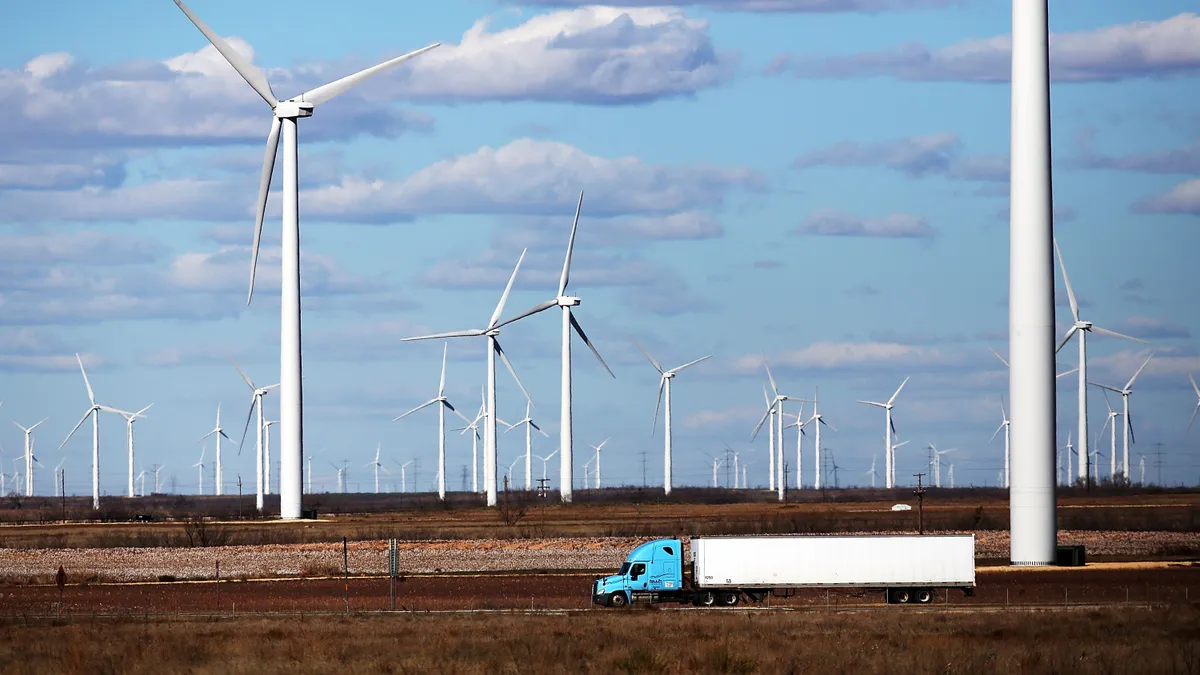Dive Brief:
-
Hydrogen technology company Plug Power has entered into a 345 MW wind power purchase agreement (PPA) with Apex Clean Energy. The energy from the wind farm, which Apex believes will be the first and largest wind-powered hydrogen project in the U.S., will power one of a series of liquid hydrogen plants Plug plans to build by 2025.
-
The new hydrogen plant, which will draw power directly from one of Apex's wind farms under development in Texas, will be capable of producing 30 metric tons of liquid hydrogen per day, which Plug Power estimates is enough to fuel over 1,000 heavy-duty class 8 trucks.
-
The plant's 30-ton capacity will be enough to supply three-fourths of Plug Power's current hydrogen demand, according to company Chief Strategy Officer Sanjay Shrestha, but is only a first step toward the company's goal to "make hydrogen ubiquitous."
Dive Insight:
Demand for renewable energy may be driving hydrogen development in some parts of the world, but in Texas the need for hydrogen is expanding the state's renewable energy generation.
Apex Clean Energy and Plug Power, a supplier of hydrogen-based technologies, announced Wednesday that they have entered into a 345 MW wind PPA from one of Apex's wind farms under development in Texas. Energy from the wind farm will power a 30 metric ton liquid hydrogen plant, which Plug Power estimates will provide a little less than half the hydrogen they anticipate will be required by large distribution centers run in the near future.
Plug's core business, according to Shrestha, currently involves providing hydrogen fuel cells and refueling infrastructure to companies including Walmart and Amazon, which use hydrogen to power forklifts inside their massive distribution centers. Shrestha said Plug Power anticipates demand from these customers alone will exceed 100 tons of hydrogen per day by 2025, creating a need for Plug to develop hydrogen generation capacity. Plug currently sells about 40 tons of hydrogen per day, Shrestha said.
To ensure their hydrogen is carbon-free, Shrestha said, Plug opted to use electrolysis — splitting water into hydrogen and oxygen using electricity — to produce hydrogen instead of extracting the fuel from carbon-based resources. While some have envisioned using curtailed renewable energy from the grid to drive electrolysis, there currently isn't enough curtailed energy available to drive a 30-ton hydrogen plant, which will require about 80 MWh at full capacity, Shrestha said. That's where the PPA comes into play.
The PPA was sized so that the wind farm's average generation is matched with the electrolyzers' 24-7 demand for energy, according to Mark Goodwin, president and CEO of Apex Clean Energy. When wind production exceeds the plant's needs, the excess energy will be put out on the grid via an interconnection in the Texas grid. When production falls below what's needed, Plug will draw power from the grid.
Plug Power also has additional hydrogen plants in the works, including a 15-ton plant announced in Georgia, and a larger plant run on hydropower planned near Buffalo, New York. While this is the first partnership between Plug and Apex, Shrestha indicated it could be the "first of many" agreements between the two companies.
With its large energy needs, Goodwin said hydrogen production by itself could prove a boon to clean energy developers, who he said need large customers like Plug to help finance large renewable energy projects. But he didn't discount the possibility of hydrogen as a generation asset in the future.
"I think it's quite likely there will be financings that have renewable facilities and electrolyzers, and the fanciable offtake is a long-term contract to buy hydrogen," Goodwin said. "That's right up our alley in energy resources."














